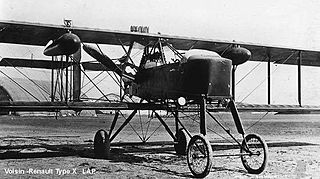
The Voisin III was a French World War I two-seat pusher biplane multi-purpose aircraft developed by Voisin in 1914 as a more powerful version of the 1912 Voisin I. It is notable for being the aircraft used for the first successful shooting down of an enemy aircraft on October 5, 1914, and to have been used to equip the first dedicated bomber units, in September 1914.

Aéroplanes Voisin was a French aircraft manufacturing company established in 1905 by Gabriel Voisin and his brother Charles, and was continued by Gabriel after Charles died in an automobile accident in 1912; the full official company name then became Société Anonyme des Aéroplanes G. Voisin. During World War I, it was a major producer of military aircraft, notably the Voisin III. After the war Gabriel Voisin abandoned the aviation industry, and set up a company to design and produce luxury automobiles, called Avions Voisin.

The Dorand AR.1 was a World War I French two-seat observation biplane aircraft used by the French Air Force, the American Expeditionary Force and, in small numbers, by Serbian Aviation.

The Caudron R.11, was a French three-seat twin-engine long range escort fighter biplane developed and produced by Caudron during the First World War.

The SPAD S.A was a French two-seat tractor biplane first flown in 1915. It was used by France and Russia in the early stages of the First World War in the fighter and reconnaissance roles. It was a unique aircraft that carried its observer in a nacelle ahead of both wing and engine.

The SPAD S.XII or SPAD 12 was a French single-seat biplane fighter aircraft of the First World War developed from the successful SPAD VII by Louis Béchereau, chief designer of the Société Pour L'Aviation et ses Dérivés (SPAD).

The Nieuport 14 was a military reconnaissance sesquiplane produced in France during the First World War. The French Army deployed it in 1916 but the type was quickly withdrawn from front-line service.

The Voisin Triplanes were large experimental bombers built by Voisin in 1915 and 1916. After unsuccessful trials of the 1915 prototype a modified version with more powerful engines was built in 1916, as the Voisin E.28, but the type did not enter production.
The Voisin VI or Voisin Type 6 was a French pusher biplane bomber aircraft of World War I.
The Tellier T.2 was a French two-seat patrol biplane flying-boat built by Société Alphonse Tellier et Cie à Neuilly (hull) and Voisin (wings). The wooden-hull flying boat used a 150 kW (200 hp) Hispano-Suiza 8Ba engine and was first flown in June 1916.

The Nieuport 15 was a French World War I bomber aircraft. Due to disappointing performance the type was rejected and never entered service.
The Astra 1916 bomber was a large 3-engined biplane, with two fuselages and a central nacelle. Power was supplied by three 220 hp (160 kW) Renault 12Eb water-cooled V-12 piston engines, two tractor engines in the noses of the fuselages and a pusher engine at the rear of the central nacelle. The flight crew of two sat in individual cockpits in the central nacelle and a gunner were housed in a cockpit, aft of the wings, in each fuselage. Designed for a 1916 concours puissant the performance of the aircraft was unsatisfactory and further development was abandoned.

The Voisin VIII was a French two-seat biplane pusher which was built in two versions, one fitted with a 37mm Hotchkiss cannon, and the other as a conventional bomber. Problems with the Peugeot engine led to a short operational career with front line units before being superseded by the Voisin X, which aside from the installation of a new Renault engine, was nearly identical to the VIII.

The Voisin X was a French two-seat pusher biplane which was built in two versions, one fitted with a 37 mm (1.46 in) Hotchkiss cannon, and the other as a conventional night bomber. Problems with the Peugeot engine in the previous Voisin VIII led to the installation of a new Renault engine of greater power and reliability, but the new aircraft was otherwise nearly identical to the VIII. Despite its obsolescence, it would make up the bulk of front line night bomber escadrilles until the end of the war.
The Henri Farman HF.35 was a large 3-seat biplane designed and built in France by Henri Farman during 1915.

The Voisin XII was a prototype French two-seat four-engine biplane bomber built near the end of the First World War but which did not enter service.

The Voisin IV was a French two-seat bomber and ground attack aircraft of World War I.
The Maurice Farman MF.16 was a French reconnaissance aircraft developed before World War I by the Farman Aviation Works.

The Paul Schmitt P.S.7 was a French World War I two-seat biplane bomber that dispensed with the novel variable incidence wing used on prior designs.

The Paul Schmitt P.S.3 was a French World War I biplane bomber that was built in small numbers but primarily used as a trainer.
















